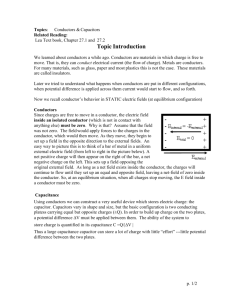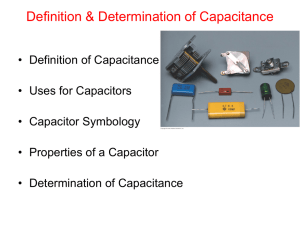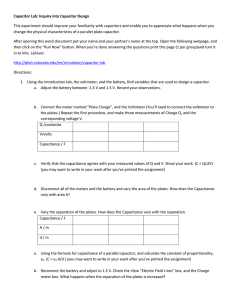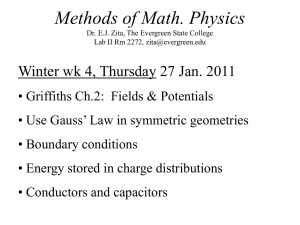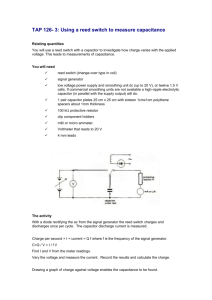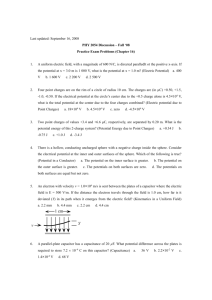W05D1_Conductors and Insulators_mac_v03_jwb
advertisement
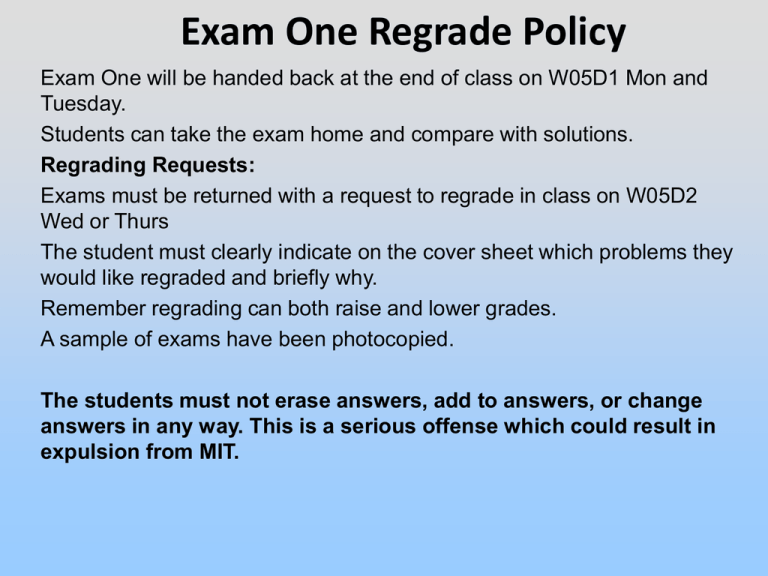
Exam One Regrade Policy Exam One will be handed back at the end of class on W05D1 Mon and Tuesday. Students can take the exam home and compare with solutions. Regrading Requests: Exams must be returned with a request to regrade in class on W05D2 Wed or Thurs The student must clearly indicate on the cover sheet which problems they would like regraded and briefly why. Remember regrading can both raise and lower grades. A sample of exams have been photocopied. The students must not erase answers, add to answers, or change answers in any way. This is a serious offense which could result in expulsion from MIT. W05D1 Conductors and Insulators Capacitance & Capacitors Energy Stored in Capacitors W05D1 Reading Assignment Course Notes: Sections 3.3, 4.5, 5.1-5.4, 5.6, 5.8 2 Announcements No Math Review this week PS 4 due W05 Tuesday at 9 pm in boxes outside 32082 or 26-152 W05D2 Reading Assignment Course Notes: Sections 5.4, 5.6, 5.8-5.9 3 Outline Conductors and Insulators Conductors as Shields Capacitance & Capacitors Energy Stored in Capacitors 4 Conductors and Insulators Conductor: Charges are free to move Electrons weakly bound to atoms Example: metals Insulator: Charges are NOT free to move Electrons strongly bound to atoms Examples: plastic, paper, wood 5 Charge Distribution and Conductors The Charged Metal Slab Applet: Non-zero charge placed in metal slab http://web.mit.edu/viz/EM/visualizations/electrostatics/CapacitorsAndCondcutors/chargedmetalslab/chargedmetalslab.htm Charges move to surface (move as far apart as possible) Electric field perpendicular to surface, zero inside slab 6 Induced Charge Distribution in External Electric Field Charging by Induction, Exterior of a Neutral Metallic Box http://web.mit.edu/viz/EM/visualizations/electrostatics/ChargingByInduction/chargebyinductionBox/chargebyinductionBox.htm Induced charges move to surface Electric field perpendicular to surface, zero inside slab 7 Conductors in Equilibrium Conductor Placed in External Electric Field 1)E = 0 inside 2) E perpendicular to surface 3) Induced surface charge distribution 8 Hollow Conductors: Applet Charge placed OUTSIDE induces charge separation ON OUTSIDE. Electric field is zero inside. http://web.mit.edu/viz/EM/visualizations/electrostatics/ChargingByInduction/shielding/shielding.htm 9 Electric Field on Surface of Conductor 1) E perpendicular to surface 2) Excess charge on surface Apply Gauss’s Law A Esurface A Esurface 0 0 10 Conductors are Equipotential Surfaces 1) Conductors are equipotential objects 2) E perpendicular to surface 11 Group Problem: Metal Spheres Connected by a Wire Two conducting spheres 1 and 2 with radii r1 and r2 are connected by a thin wire. What is the ratio of the charges q1/q2 on the surfaces of the spheres? You may assume that the spheres are very far apart so that the charge distributions on the spheres are uniform. 12 Concept Question: Point Charge in Conductor A point charge +q is placed inside a hollow cavity of a conductor that carries a net charge +Q. What is the total charge on the outer surface of the conductor? 1. Q. 2. Q + q. 3. q. 4. Q - q. 5. Zero. 13 Concept Q. Ans.: Point Charge in Conductor Answer 2. Choose Gaussian surface inside conductor. Electric field is zero on Gaussian surface so flux is zero. Therefore charged enclosed is zero. So an induced charge –q appears on cavity surface. Hence an additional charge of +q appears on outer surface giving a total charge of Q + q on outer surface. 14 Hollow Conductors: Applet Charge placed INSIDE induces balancing charge ON INSIDE. Electric field outside is field of point charge. http://web.mit.edu/viz/EM/visualizations/electrostatics/ChargingByInduction/shielding/shielding.htm 15 Capacitors and Capacitance Our first of 3 standard electronics devices (Capacitors, Resistors & Inductors) 16 Capacitors: Store Electric Charge Capacitor: Two isolated conductors Equal and opposite charges ±Q Potential difference V between them. Q C V Units: Coulombs/Volt or Farads C is Always Positive 17 Parallel Plate Capacitor; Applet Oppositely charged plates: Charges move to inner surfaces Electric field perpendicular to surface, zero inside plates http://web.mit.edu/viz/EM/visualizations/electrostatics/CapacitorsAndCondcutors/capacitor/capacitor.htm 18 Calculating E (Gauss’s Law) qin E dA S 0 AGauss E AGauss 0 Q E 0 A 0 Note: We only “consider” a single sheet! Doesn’t the other sheet matter? 19 Superposition Principle Between the plates: E E E ˆ ˆ j j ˆj 2 0 2 0 0 Above the plates: E E E ˆ ˆ j j0 2 0 2 0 Below plates: ˆ ˆ E E E j j0 2 0 2 0 20 Parallel Plate Capacitor top Q V E dS Ed d A 0 bottom 0 A Q C d V C depends only on geometric factors A and d 21 Group Problem: Spherical Shells A spherical conductor of radius a carries a charge +Q. A second thin conducting spherical shell of radius b carries a charge –Q. Calculate the capacitance. 22 Concept Question: Isolated Spherical Conductor What is the capacitance of an isolated spherical conductor of radius a? 1.Capacitance is not well defined. 2.Capacitance is 4 0 a. 3.Capacitance is infinite. 4.Capacitance is zero. 23 Concept Q. Ans. Isolated Spherical Conductor Answer 2. Capacitance is 4 0 a Other equipotential surface (second conducting surface) is located at infinity. In previous calculation set . b 4 0 4 0 Q C 4 0 a 1 1 1 1 V a b a 24 Capacitance of Earth For an isolated spherical conductor of radius a: C 40 a 0 8.85 10 12 Fm a 6.4 10 m 6 4 C 7 10 F 0.7mF A Farad is REALLY BIG! We usually use pF (10-12) or nF (10-9) 25 Energy To Charge Capacitor +q -q 1. Capacitor starts uncharged. 2. Carry +dq from bottom to top. Now top has charge q = +dq, bottom -dq 3. Repeat 4. Finish when top has charge q = +Q, bottom -Q 26 Stored Energy in Charging Capacitor At some point top plate has +q, bottom has –q Potential difference is V = q / C Change in stored energy done lifting another dq is dU = dq V 27 Stored Energy in Charging Capacitor So change in stored energy to move dq is: q 1 dU dqV dq q dq C C Total energy to charge to Q Q 2 1 1Q U dU q dq C0 C 2 28 Energy Stored in Capacitor Q Since C V 2 Q 1 1 U Q V C V 2C 2 2 2 Where is the energy stored??? 29 Energy Stored in Capacitor Energy stored in the E field! C Parallel-plate capacitor: o A d and V Ed 2 2 A E 1 1 o 2 U CV Ed o ( Ad ) u E (volume) 2 2 d 2 Energy density [J/m3] uE o E 2 2 30 Demonstration: Changing Distance Between Circular Capacitor Plates E4 http://tsgphysics.mit.edu/front/?page=demo.php&letnum=E%204&show=0 31 Concept Question: Changing Dimensions A parallel-plate capacitor is charged until the plates have equal and opposite charges ±Q, separated by a distance d, and then disconnected from the charging source (battery). The plates are pulled apart to a distance D > d. What happens to the magnitude of the potential difference V and charge Q? 1. 2. 3. 4. 5. 6. 7. 8. 9. V, Q increases. V increases, Q is the same. V increases, Q decreases. V is the same, Q increases. V is the same, Q is the same. V is the same, Q decreases. V decreases, Q increases. V decreases, Q is the same. V decreases, Q decreases. 32 Concept Q. Answer: Changing Dimensions Answer: 2. V increases, Q is the same With no battery connected to the plates the charge on them has no possibility of changing. In this situation, the electric field doesn’t change when you change the distance between the plates, so: V=Ed As d increases, V increases. 33 Concept Question: Changing Dimensions A parallel-plate capacitor is charged until the plates have equal and opposite charges ±Q, separated by a distance d. While still connected to the charging source, the plates are pulled apart to a distance D > d. What happens to the magnitude of the potential difference V and charge Q? 1. V, Q increases. 2. V increases, Q is the same. 3. V increases, Q decreases. 4. V is the same, Q increases. 5. V is the same, Q is the same. 6. V is the same, Q decreases. 7. V decreases, Q increases. 8. V decreases, Q is the same. 9. V decreases, Q decreases. 34 Concept Q. Answer: Changing Dimensions Answer: 6. V is the same, Q decreases With a charging source (battery) connected to the plates the potential V between them is held constant In this situation, since V=Ed As d increases, E must decrease. Since the electric field is proportional to the charge on the plates, Q must decrease as well. 35 Concept Question: Changing Dimensions A parallel-plate capacitor, disconnected from a battery, has plates with equal and opposite charges, separated by a distance d. Suppose the plates are pulled apart until separated by a distance D > d. How does the final electrostatic energy stored in the capacitor compare to the initial energy? 1. The final stored energy is smaller 2. The final stored energy is larger 3. Stored energy does not change. 36 Concept Q. Answer: Changing Dimensions Answer: 2. The stored energy increases As you pull apart the capacitor plates you increase the amount of space in which the E field is non-zero and hence increase the stored energy. Where does the extra energy come from? From the work you do pulling the plates apart. 37 Demonstration: Charging Up a Capacitor A 100 microfarad oil-filled capacitor is charged to 4 KV and discharged through a wire Stored Energy: 1 1 2 4 3 2 U CV (1 10 F)(4 10 V) 800 J 2 2 http://tsgphysics.mit.edu/front/?page=demo.php&letnum=E%206&show=0 38
